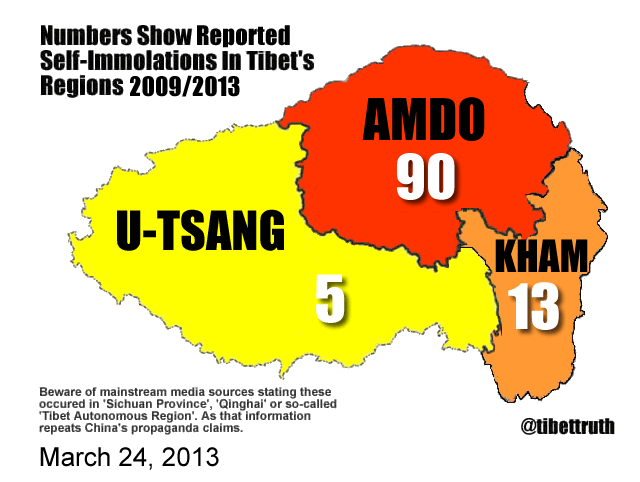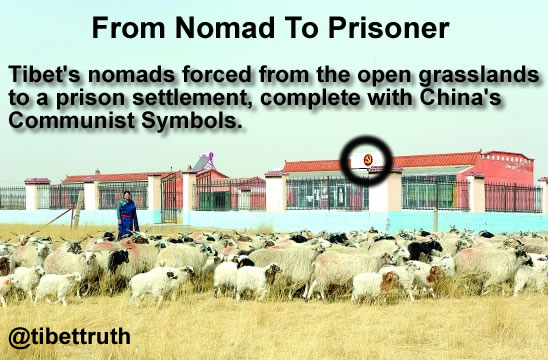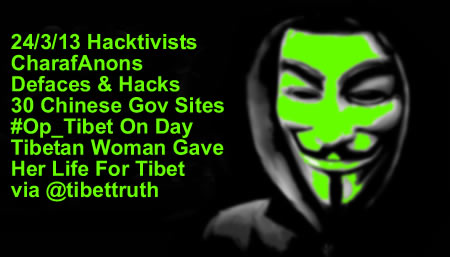-
YESHE.
User deleted
Tibet : Alarming new surveillance,restrictions tightened on Tibetans
Redazione - Gio, 21/03/2013 - 10:10
The Chinese government’s announcement that it will expand a pervasive new security system throughout Tibet despite an already heavy security presence raises grave concerns about threats to human rights of this intrusive monitoring across the region.Officials announced the system’s expansion in the annual work report, which was released on February 7, 2013.Official documents describe the new system, known as “grid” (Tib.: drwa ba, Ch.: wangge) management, as designed to improve public access to basic services. But the system also significantly increases surveillance and monitoring, particularly of “special groups” in the region – former prisoners and those who have returned from the exile community in India, among others. Expansion of the grid system, alongside the construction across Tibet of over 600 “convenience police-posts” with high-tech equipment to monitor daily life, and increasingly active volunteer security groups known as “Red Armband Patrols” (Tib.: dpung rtag dmar po) in 2012, means that surveillance is now a pervasive part of life across the region.
In January 2012, following instructions from China’s then-President Hu Jintao, the TAR government announced that it would implement the grid system, first introduced in 2007 in Beijing, as the key to “social stability maintenance” in Tibet, thus “putting a dragnet into place to maintain stability.” On February 17, 2013, Yu Zhengsheng, Standing Committee member of the Political Bureau of the Communist Party of China (CPC) Central Committee and the top official in China in charge of nationality policy, confirmed that the system should be put into effect throughout the region to form “nets in the sky and traps on the ground,” an indication that the system is primarily designed for surveillance and control.
The system is staffed mostly by civilians rather than government officials, usually with a Communist Party member in each office, to manage surveillance and control operations. Party membership in Tibet requires articulating opposition to, among other things, increased Tibetan autonomy, independence, or the Dalai Lama, thus raising concerns that political criteria rather than violations of law may serve as the basis of surveillance, searches, or detentions.
In the new grassroots level of urban administration, each “neighborhood” or “community” area in towns will be divided into three or more grid units. At least eight pilot units were set up in Lhasa in April 2012, and in September were declared to have “achieved notable results.” On October 9, the regional party secretary stated that because “the Lhasa practice has fully proved the effectiveness of implementing grid management to strengthen and innovate social management,” the system should be made universal in “the towns, rural areas, and temples”.
The grid offices are closely linked to “Red Armband Patrols,” which also typically include local Communist Party members. Such patrols handle traffic and low-level street management throughout China at times of extra tension, but, according to Tibetans from Lhasa, since May 2012 these patrols have been involved in much more intrusive actions in Tibet, including searching homes for materials relating to the Dalai Lama or other perceived indications of dissident opinion.
In addition, by July 2012, 676 permanent, street-side “convenience police-posts” (Ch.: bian minjing wu zhan) had been set up in towns across the region. These are equipped with computers and video technology for computerized checks of people passing through on a “case-by-case” basis. Police officers who staff the posts are required to be on duty around-the-clock.
www.rfa.org/english/news/tibet/nets-03212013161127.html
Breaking: 110th Tibetan Self-immolation
Phayul[Sunday, March 24, 2013 21:42]
DHARAMSHALA, March 24: A Tibetan woman today set herself on fire in an apparent protest against China’s continuing occupation of Tibet.
Thirty-year-old Kal Kyi, a mother of four has set herself ablaze protesting near Jonang monastery in Zamthang in Eastern Tibet at 3:30 pm (local time).
“The local Tibetans carried her charred body inside the monastery premises to prevent it from falling into the hands of Chinese security personnel,’ said Tsangyang Gyatso, an exile Tibetan who has close contacts in the region.
Kal Kyi had died from injuries. Kyi is survived by her husband, Gyepo, and their four children.
Last year in May, another Tibetan woman, Rikyo 33 has set herself on fire near the Jonang Zamthang Gonchen monastery in Zamthang County, which is located in Ngaba, the nerve centre of the ongoing wave of self-immolations in Tibet.
With Kyi’s self-immolation the confirmed number of Tibetan self-immolation has reached 110. The primary demand of those who set themselves on fire are freedom for Tibet and return of His holiness the Dalai lama from exile.
Fourteen Tibetans have self-immolated since the beginning of this year. Eight of them happened in February alone.
Breaking: Second self-immolation in 24 hours, Toll rises to 111
Phayul[Monday, March 25, 2013 13:06]
DHARAMSHALA, March 25: Within 24 hours of Kal Kyi’s self-immolation in Zamthang, another Tibetan has set himself on fire today in an apparent protest against China’s continuing occupation of Tibet.
Forty-three-year old Lhamo Kyab set himself ablaze at Lushoe village in Tsoe region, Eastern Tibet. The self-immolation took place around 10 am (local time).
This is the fifth self-immolation protests in Tsoe since Sangay Gyatso set himself on fire on October 6 last year.
Kyab’s self-immolation is the second such case in a day. Thirty-year-old Kal Kyi, a mother of four has set herself ablaze yesterday in Eastern Tibet at 3:30 pm (local time). She died at the protest site.
The deepening crisis inside Tibet has witnessed large-scale anti-China protests in 2008 and a series of self-immolations since 2009.
There have now been 111 confirmed reports of self-immolation in the last five years. The overwhelming number of them have demanded freedom for Tibet and return of the Dalai Lama from exile.
Further detail about Kyab current status is not available at the time of filing this report.
 .
.
Free Tibet ?!?! Free violence !!! |
